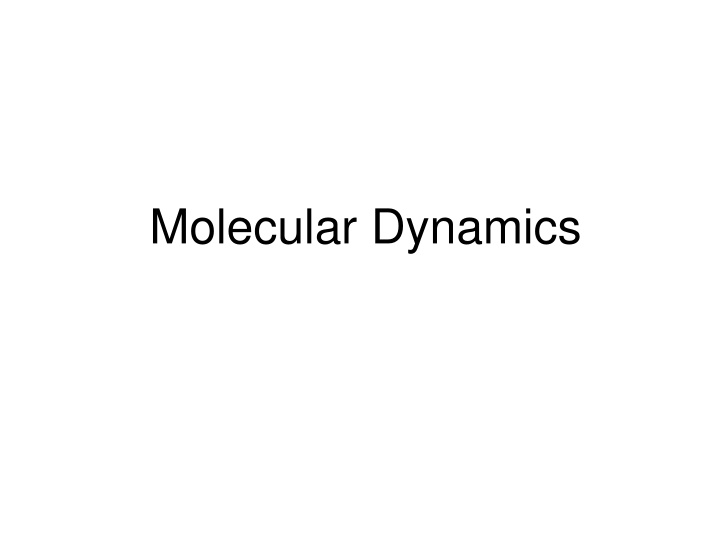
Molecular Dynamics Simulation Techniques and Force Fields
Explore the world of molecular dynamics simulation, including the use of force fields and various ensembles like micro-canonical and canonical. Learn about solving Newton's equations of motion, choosing appropriate potentials, and implementing Langevin dynamics for accurate simulations.
Download Presentation

Please find below an Image/Link to download the presentation.
The content on the website is provided AS IS for your information and personal use only. It may not be sold, licensed, or shared on other websites without obtaining consent from the author. If you encounter any issues during the download, it is possible that the publisher has removed the file from their server.
You are allowed to download the files provided on this website for personal or commercial use, subject to the condition that they are used lawfully. All files are the property of their respective owners.
The content on the website is provided AS IS for your information and personal use only. It may not be sold, licensed, or shared on other websites without obtaining consent from the author.
E N D
Presentation Transcript
Basic Idea Solve Newton s equations of motion 2 r d dt V r j = = = F F , , 1,2, , m j N j j j 2 j Choose a force field (specified by a potential V) appropriate for the given system under study Decide a statistical ensemble to use, choose boundary conditions; collect statistics of observables
Commonly Use Force Fields Lennard-Jones potential For noble gas and generic fluids Tersoff, Brenner, Stillinger-Weber, 3-, 4- body potentials For C, Si, Ge, AMBER, CHARMM, GROMOS, MM4, etc For biomolecules GULP, LAMMPS, DFT codes (QE), etc
Example of potential used in biomolecular modeling k k ( ) ( ) 2 2 = + ( , , r r r i i , ) V l l 1 2 ,0 ,0 N i i i i 2 2 bonds angles V ( ) + 1 cos( + n ) n 2 torsions 12 6 q q ij ij i j r + + 4 ij 4 r r i j 0 ij ij ij Machine learning based force fields
Ensembles Micro-Canonical Ensemble Total energy is fixed, standard Hamiltonian dynamics Canonical Ensemble Need to use thermostat to fix temperature Langevin dynamics Nos -Hoover Generalized Langevin Stochastic velocity rescaling
Langevin Dynamics 2 r F d dt j j = + = v , 1,2, , j N j j 2 m = ( ) t 0, 2 k T m = T B ( ) ( ') t ( ') t t t I How to correctly implement the white noise on computer?
Solving the Langevin equation F v + = + + v v v B ( ) ( ) t t h h m t + = + + r r ( ) ( ) t ( ) t h h h where h = B ( ) t dt 0 is a Gaussian random vector with each component 2 0, B B m k Th = = = 2 , , , x y z B
Nos-Hoover Dynamics r p d dt d dt d dt j j = = v , j m p j = F p , j j 1 1 2 K K = = 2 j v 1 , K m 2 j 0 = / 2 K N k T 0 f B
Stochastic Velocity Rescaling for Canonical Ensemble 1. Evolve with a time step by a symplectic algorithm (e.g. second order velocity Verlet) 2. Compute kinetic energy K, and evolve K according to ?+ 2 ??0 ????? ? = ? + ?0 ? 3. Rescale velocity ? ??, to enforce the target ?
Generalized Langevin t = + r ( ') ( ') t u t dt ' u F t = ( ) t 0, = ( ) t ( ') t ( ') i t t is known as self-energy
Observables, Statistics Equilibrium temperature (in micro-canonical ensemble) by the equipartition theorem. 1 1 2 2 = = 2 j , , , x y z k T m v , B j Pressure of a fluid (for pair potential) 1 d r = + r F ( ) PV Nk T B i j ij i j Where d is dimension, Fij is the force acting on particle i from particle j.
Transport Coefficients The diffusion constant can be computed through the velocity correlation function 2 r r ( ) t (0) = = v v ( ) t (0) lim t 3 dt D 2 t 0
Transport Coefficients Thermal conductivity can be computed through energy-current correlation using Green-Kubo formula; or nonequilibrium simulation by directly computing the energy current + 1 J V = = ( ) (0) J t J dt T 2 k T V B 0
Conductance of graphene strips Sites 0 to 7 are fixed left lead and sites 28 to 35 are fixed right lead. Heat bath is applied to sites 8 to 15 at temperature TL and site 20 to 27 at TR. Wang, Ni, & Jiang, PRB 2009.
Textbooks on MD M P Allen & D J Tildesley, Computer Simulation of Liquids, (Oxford, 2017) D Frenkel & B Smit, Understanding Molecular Simulation, 3rd (Academic Press, 2023) A R Leach, Molecular Modeling, principles and applications, (Pearson, 2001)
Tutorial Problem Set 12 Prove the pressure formula (required a great deal of knowledge of statistical mechanics). 1 d r = + r F ( ) PV Nk T B i j ij i j assuming pair-wise central force ???
